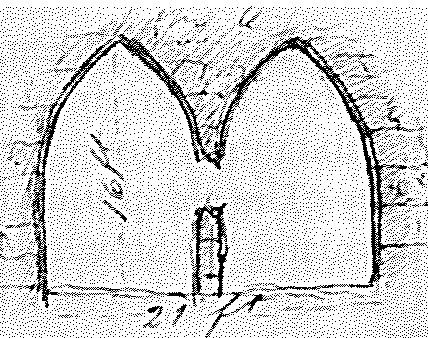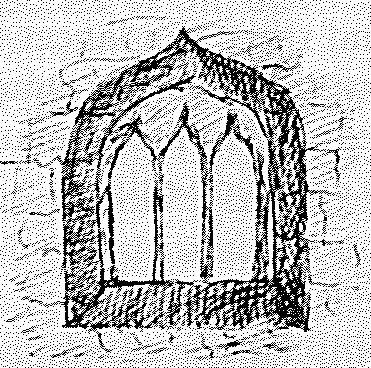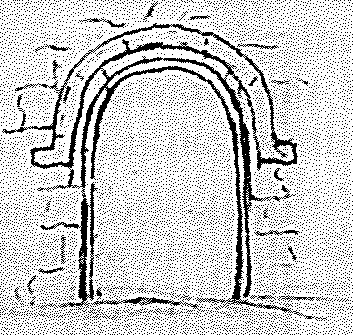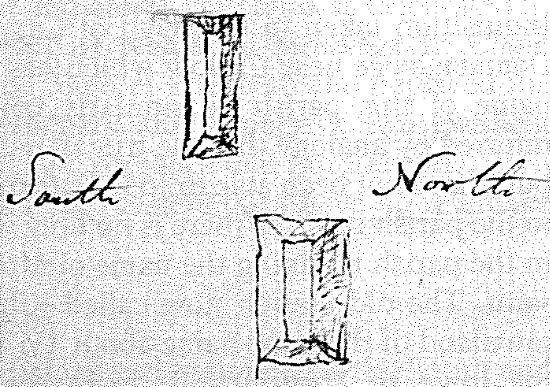[Hand of P. O'Keeffe:]
Sir,
Mr. O'Donovan and I having divided the work of the Barony of Longford, between us, as he has already stated, my task has been to visit the Parishes of Kilquain, Meelick, Dononaughta, Kiltormer and Killoran.
OF THE PARISH OF KILQUAIN
This parish situated about 4½ miles W {by S.} of Eyrecourt, is in English called by the alias name of Quainsborough, in Irish always Cill Chuáin, which means the Church of Cuán a name very common among the Irish Saints. This Kill-Chuain must be another establishment belonging to the famous Cuan of Ath-Eascrach (Cuán) {Ahascragh} whose festival is still celebrated at that place on the 15th of October. The origin of the name Kill-Chuain or the founder or Patron-saint is not remembered by the inhabitants whom I consulted.
The old church (and burial ground) of Cill Chuain, is according to the people, situated in the townland of Stowlin, which, I have been told, is a modern subdivision
of Kilquain or Quainsborough which it adjoins. It is not mentioned in the Name-Book. This ruined building is about 32½ ft. long, and about 20 feet broad. The North side-wall is nearly level with the ground, except towards the East, where about 2 yards in length remain. The East gable is down, except 2 yards towards the South corner. The South side-wall is nearly perfect, on which about 6½ ft. from the East end there is a lancet window the upper part of which is entirely removed; it is about 7 inches wide outside. On the same wall there is a large breach within about 10 ft. of the West gable, which is reduced to the level of the side-walls and has neither window nor door. The S.E. corner of the church is covered with ivy.
OF THE PARISH OF MEELICK
This Parish which is in Irish called by the inhabitants Míliuc, lies in the vicinity of the Town of Eyrecourt. The meaning of the name is not known by the people, nor explained by any topographical writers of authority, as far as we have as yet discovered. It would appear to be a measure of land, as leath mhílic {half-mílic} as well as leath ceathramhadh {half-quarter} &c. occurs in the names of Townlands.
In Archdall's Monasticon Hibernicum {Co. Galway} (p. 294) we read as follows
Milick (Wadding calls the place Mylescin)
On the River Shannon about four miles South-east of Clonfert in the barony of Longford.
In the year 1203, we are told that William de Burgh marched at the head of a great army into Connaught and so to Milick, and did there profanely convert the church into a stable round which he erected a castle of a circular form, wherein he was seen to eat flesh meat during the whole time of Lent. (Ann Munster Contin.) [In left-hand margin beside this paragraph: In the printed (published) copies of the Monasticon, this paragraph is given after the one here following; but the author has corrected the errors in his own copy now in R.I.A.]
O Madden, dynast of Silamchia (the Barony of Longford) founded a monastery here in 1479 for conventual Franciscan friars (War Mon). The situation was delightful, and the building itself spacious and beautiful (King page 323). During the winter months the friary was surrounded by the inundations of the river (War Mon).
The monastery of Milick was afterwards granted to Sir John King, who assigned it to the Earl of Clanrickard (Aud. Gen.).
The Four Masters also record the erection of this Monastery thus:
Ao.Ci. 1479. The Monastery of Miliuc was founded by O'Madden on the banks of the Shannon in the Diocese of Clonfert for Franciscan friars; and he selected a burial place for himself in it.
The ruins of this monastery are still to be seen on the bank of the River Shannon about 2½ miles S.E. of Eyrecourt in the townland called "Friars' part of Meelick"(Name Book). They are more than 100 ft. long, and about 26 feet broad, the walls being lofty. The North side-wall appears perfect; the East gable is level with the ground.
On the South side-wall very near the E. end there is a door-way in the curvilineally-pointed style about 16 ft. high and 10 ft. wide. On the same wall near the W. there is a double door-way in the same style slightly injured thus:

This leads to a branch-building the walls of which are now not above 5 or 6 feet high. In the middle of the S. side-wall are likewise two windows presenting this appearance inside:

There is a window on the West gable somewhat similar to the above, but the openings are round at top thus,  under which is a door-way semicircularly formed at the top, thus -
under which is a door-way semicircularly formed at the top, thus -

In the E. wall of the branch-building (which is) attached to the South side-wall is inserted a stone bearing an inscription which mentions several (persons) of the name Cananan, who died respectively in 1721, 1743, 1767, 1770, & 1817, and were interred here. In the western wall of the same building is a stone inscribed,
ME FIERI FECERUNT P
RO SE, ET POSTERIS SU
IS HUGO CUOLLACH-
AN, ET IZABELLA MA
DDEN, UXOR EIUS
DIE XX MENSIS
MAY 1673
We find a tomb (stone) inscribed to Dority Madden, the wife of Patrick Burke, who {i.e. Dority} died in 1745, also a stone bearing the name of Nicholas Skerret, and several others belonging to the Maddens.
In the townland of Meelick at the distance of about 3/4(?) of a mile from the Abbey to the N.E. (?) (and very near the boundary of Glanavadogue), are (is) part of the remains of an old church. The N. and E. walls are perfectly level with the ground. The W. gable retains the height of the side-walls, but is injured; on it there is the appearance of a lancet (narrow) window open {i.e. battered} at the top. About 16 ft. of the South side-wall remain, retaining the
original height; the entrance which was (is) on this wall about a yard from the W. end, (is in the pointed style, but) is battered. The original length of the entire building would appear to be about 27 ft. and the breadth about 20 ft. It is situated in a field and has no grave-yard attached to it. The people call it Teampull an Eagluis, and say that it was the oldest burying-place in Connaught. It is not mentioned in the name-book.
Qu: can this be the church converted into a stable by William de Burgh in 1203; {see extract from Archdall} or was the church which he prophaned, one which (might have) stood on the site of the Monastery which was subsequently erected?
The following notices of Meelick {Miliuc} also occur in the Annals of the Four Masters.
1595. The sons of Redmond na Sguab, the son of Ulick Burke, {and other Burkes} went and destroyed Meelick, O'Madden's seat, Tir-athain and all the castles of the Country except Longphort (i.e. Longford). They plundered and destroyed Clonfert Brennan, and took the Bishop of that town prisoner. &c. &c. &c.
1557. {vide infra}
1557. As soon as the Lord chief Justice heard that the O'Conors of Ophaly were at Meelick he mustered an army to banish them from it, and conveyed cannon to Athlone, from thence he transported them in vessels {Boats or ships} to Meelick, while he himself led his army through Bealach an fhothair and by Lurgan Lusmhaighe. He afterwards took Meelick, and Breac-Chluain, slew Donogh, the son of Colla, together with others of the warders, and then destroyed and ravaged the entire Country. The sons of Melaghlin Balbh were banished from that Country together with the Rebels {vindictives}. The Chief Justice left an English Constable at Meelick {Master Francis} and obtained hostages from the two O'Maddens, viz: Melaghlin Modhardha and Breasal, and other hostages from Mac Coghlan, viz: his son and others, and thus was Siol-Anmchadha conquered. It was not easy to estimate or enumerate all who were destroyed on this occasion. These events took place three weeks before Lammas.
From these passages it appears that Meelick was O'Madden's seat, and that there was a castle there in 1557; but at present there are no
remains to a castle at Meelick. On enquiring about the existence of O'Madden's castle, I received the following information from the people:
1. That on an island in the Shannon opposite the coast of Meelick {or near it} called Gutáile in Irish, in English Cromwell's island, there was a castle, the place of which is now occupied by a military tower. An old man whom I conversed with said he remembered to have seen the remains of this castle.
2. That on a small island opposite the T.L. (village) of Keelogue, there was a castle called Caisleán na Darach {the Castle of the Oak} none (no part) of which now remains.
OF THE PARISH OF DONONAUGHTA:
This parish in which is situated the town of Eyrecourt, is called in Irish Dún an Ocht. The old church of Dononaughta stands in ruins in a grave-yard in the T.L. of Eyrecourt-Demesne; (as well as I could learn from the people the old Church is not mentioned - noticed - in the Name Book) it is commonly called contractedly Teampull a Dúin) (.i. Teampull Dúin an Ocht). On the W. gable (which) is nearly perfect, are two rectangular windows of the lancet form, situated thus with regard to each other, {inside}.

The upper one is about 3½ ft. high and 6+, inches wide outside, and the lower about 2 ft. by 7½ inches, being battered on the Northern side. There is a large breach in (the middle) [of] the South side-wall, the rest of it seems to retain the original height. The E. gable is completely down; and the North side-wall runs nearly the entire length being battered above (at the top). The entire length of the building was about 55 ft. and the breadth about 23 feet.
I have been told that there was an old church called Cillín(?) Íthe, situated in the (Eyrecourt) Demesne, near the house of Eyrecourt, which is now occupied by Mr. John Eyre, son of the late Coll. Eyre; but not a vestige of this church remains at present nor have I met any one who remembered to have seen it. It is said that the old name of the Demesne was Cillin Ithe, until it (& the town) received it (their) present name from the family of the Eyre, who the people say have been the proprietors since the time of Cromwell.
Just at the gate leading from the Town of Eyrecourt into the Demesne, there is a church 161 years old, which was roofless, until about 3 years ago, when it was slated, but is not used as a place of worship. A stone inserted in the South side-wall bears this inscription
ARMiGER PROPRYS SUMPTIBUS
AD HONOREM CULTUMQUE DlVIN
UM HANE EDIFICAViT ECCLESI
AM, ANNO DOMINI 1677.
It is said that a castle stood where the present house of Eyrecourt is built; part of it is still pointed out among the offices attached to the house.
Servant
P. O'Keeffe
